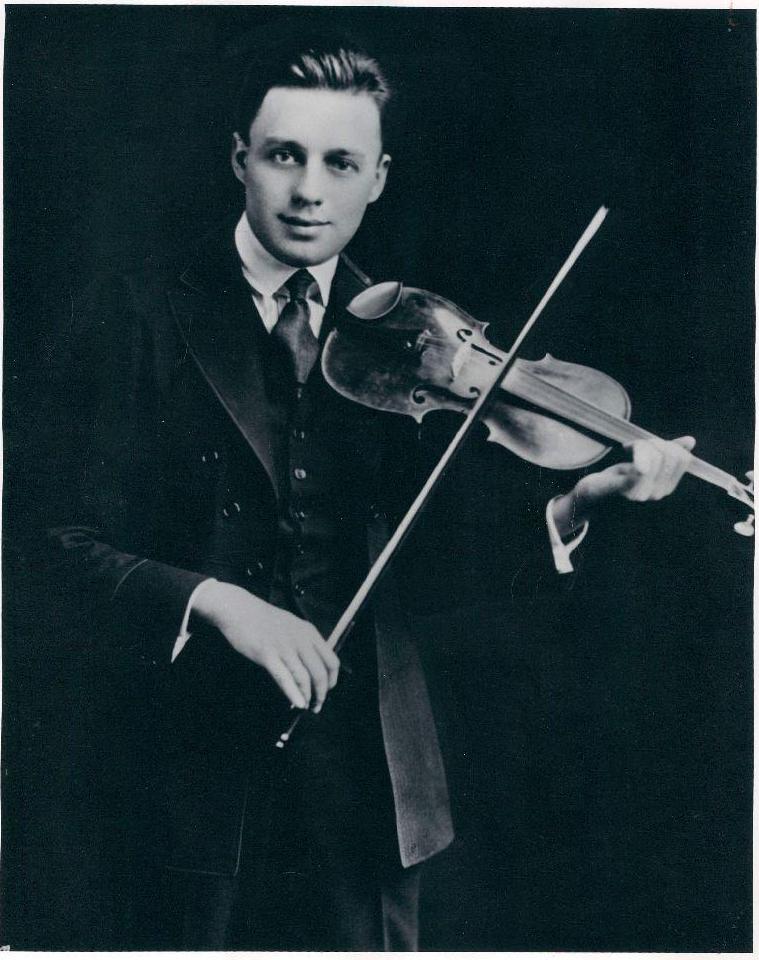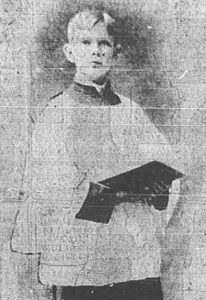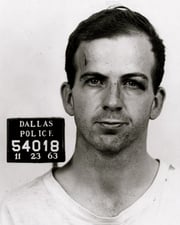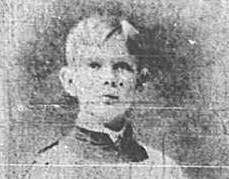
New York City, 1909—On what should have been a joyous occasion, a group of giggling young women at the Metropolitan Life Building in Manhattan set out to surprise a coworker with playful birthday kisses. What followed was a heartbreaking accident that left an entire office in shock.
George Millett, a bright-eyed 15-year-old office boy at an insurance company, had no reason to suspect that his birthday would be anything more than an ordinary workday. But as he moved about the building, six of his female colleagues—intent on celebrating the occasion in their own affectionate way—chased after him with the intention of planting kisses on his cheeks.
Whether embarrassed or simply eager to escape their pursuit, George ran. In his pocket, he carried an ink eraser, a tool commonly used in the era to carefully scrape away errors on documents. As he fled, he tripped—perhaps tangled in the flurry of skirts and laughter around him. In an instant, the eraser’s sharp point pierced his chest, striking his heart.
The girls’ playful pursuit turned to horror as George collapsed. By the time help arrived, it was too late. The young boy who had started the day as the subject of lighthearted workplace affection was now the victim of a tragic and almost unimaginable accident.
Newspapers at the time reported the incident with a mix of disbelief and sorrow. It was a freak occurrence, a cruel twist of fate that turned innocent fun into mourning. The young women, who had only wanted to bring a moment of joy to their friend, were left devastated.
But What if George Didn’t Exist?
The moment I saw this story in the History Calendar Twitter account, I knew I was looking as Benjamin Kubelsky, the most precious boy in the world!
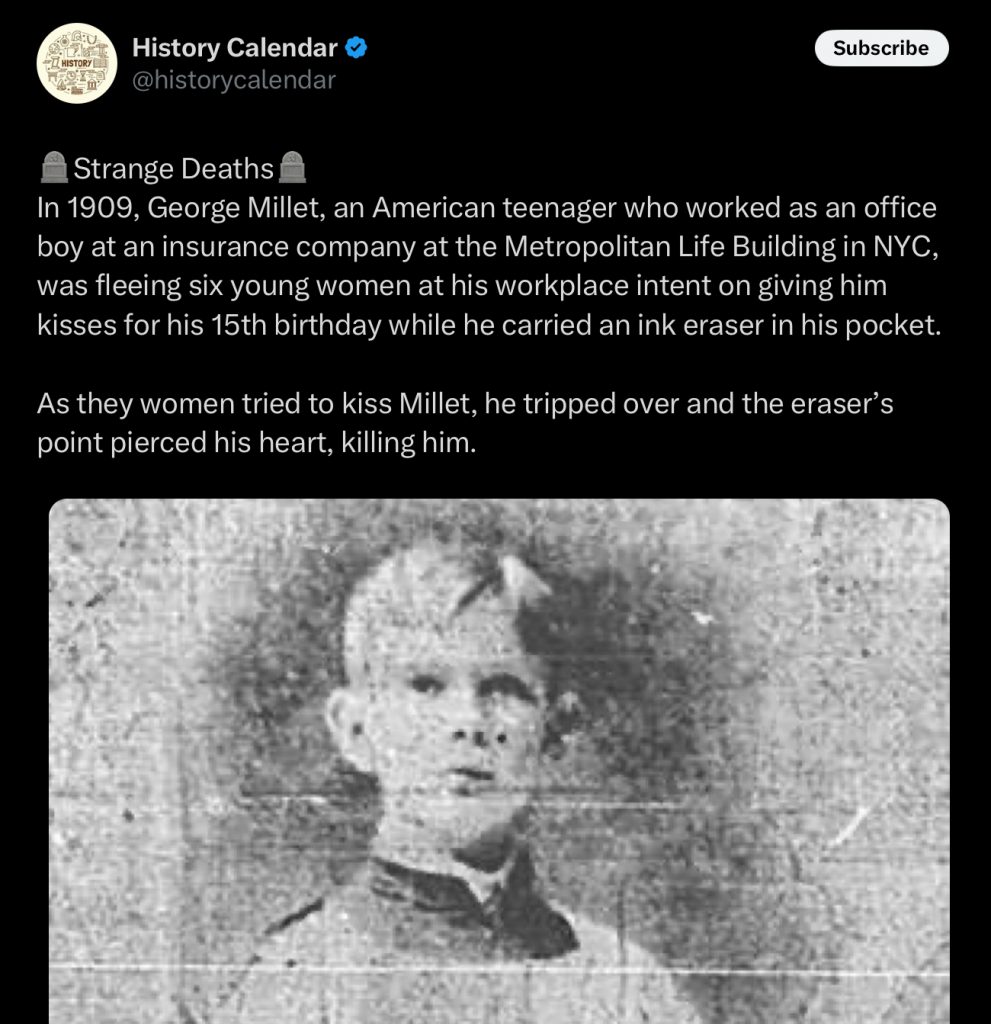
Princess Vilma Parlaghy killed George Millett!
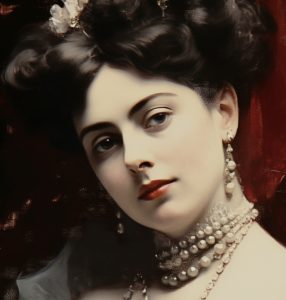 Her Serene Highness, The Princess Vilma Lwoff-Parlaghy, and her associate Minnie, invented the convoluted story of George Millet, to be placed strategically in newspapers. This storyline has been repeated countless times. All people who are invented for the purpose of playing a role in a national security operation a must shed this temporary identity in a public manner, so that we have photos, dates and keywords. The goal is to make sure the future can prove the past.
Her Serene Highness, The Princess Vilma Lwoff-Parlaghy, and her associate Minnie, invented the convoluted story of George Millet, to be placed strategically in newspapers. This storyline has been repeated countless times. All people who are invented for the purpose of playing a role in a national security operation a must shed this temporary identity in a public manner, so that we have photos, dates and keywords. The goal is to make sure the future can prove the past.
|
|
|
The Devil Always Wants A Kiss
There is a security group called “Death Takes a Holiday”, formed in the Victorian Era who fake the death of people to advance ballsy security operations. They manufacture adult characters who “get away with murder ». These are people who cause death, but nothing comes of it. Their victims are banalized in warm human-interest stories proving that they also control the media with an iron first. The purpose of this is to attract well-to-do people who want a henchman or a hit man. These faked death operations specifically target a class of people who harrass and threaten royal families. The enemy is the Old World Order, a group of old money families who used their historical proximity to royals in order to expand and protect their organized crime activities. In the 19th century, the royal families went to war against these people and scared them across the pond to “The Land of The Free” (1892+), where the legal system can deal with them very swiftly. This is why outlandish death-based stories like H.H. Holmes’ “Murder Mansion” were created.
Now that we have AI
We can now use Artificial Intelligence to validate the stories of the past. In fact, this is my new hobby! I used StanislavMichalov/Image_Face_Upscale_Restoration-GFPGAN on HuggingFace 🤗 to upscale the photo of George, and I like what I see!

 Benjamin changed his name to Jack Benny. This is the face of The Master of Ceremony. Jack Benny’s radio and television programs, were popular from 1932 until his death in 1974. He was a master of comedy who could get a laugh without ever saying a word. He was the master of the silent pause which he filled with telling gestures and looks. And he played the violin so well! For 42 years, Jack Benny was a mainstay on radio and television and all this time, he was 39!
Benjamin changed his name to Jack Benny. This is the face of The Master of Ceremony. Jack Benny’s radio and television programs, were popular from 1932 until his death in 1974. He was a master of comedy who could get a laugh without ever saying a word. He was the master of the silent pause which he filled with telling gestures and looks. And he played the violin so well! For 42 years, Jack Benny was a mainstay on radio and television and all this time, he was 39!

Jack Benny was conceived on May 1, 1893 after The 1893 World’s Fair, also known as the World’s Columbian Exposition, opened to the public in Chicago, Illinois while Her Serene Highness, The Princess Vilma Lwoff-Parlaghy won the Gold Medal from The Women’s Pavillion.
Jack Benny is part of a twin set, which is the signature of Victoria’s security network. He was born along with King Vidor, a filmmaker whose name is a direct nod to his genetic ancestry. They are both a gift from Prince George, who became Duke of York in 1893 after marrying Mary of Teck.

Born on February 08, 1894 (1894 - 1982) King VidorAmerican film director, film producer, and screenwriter |
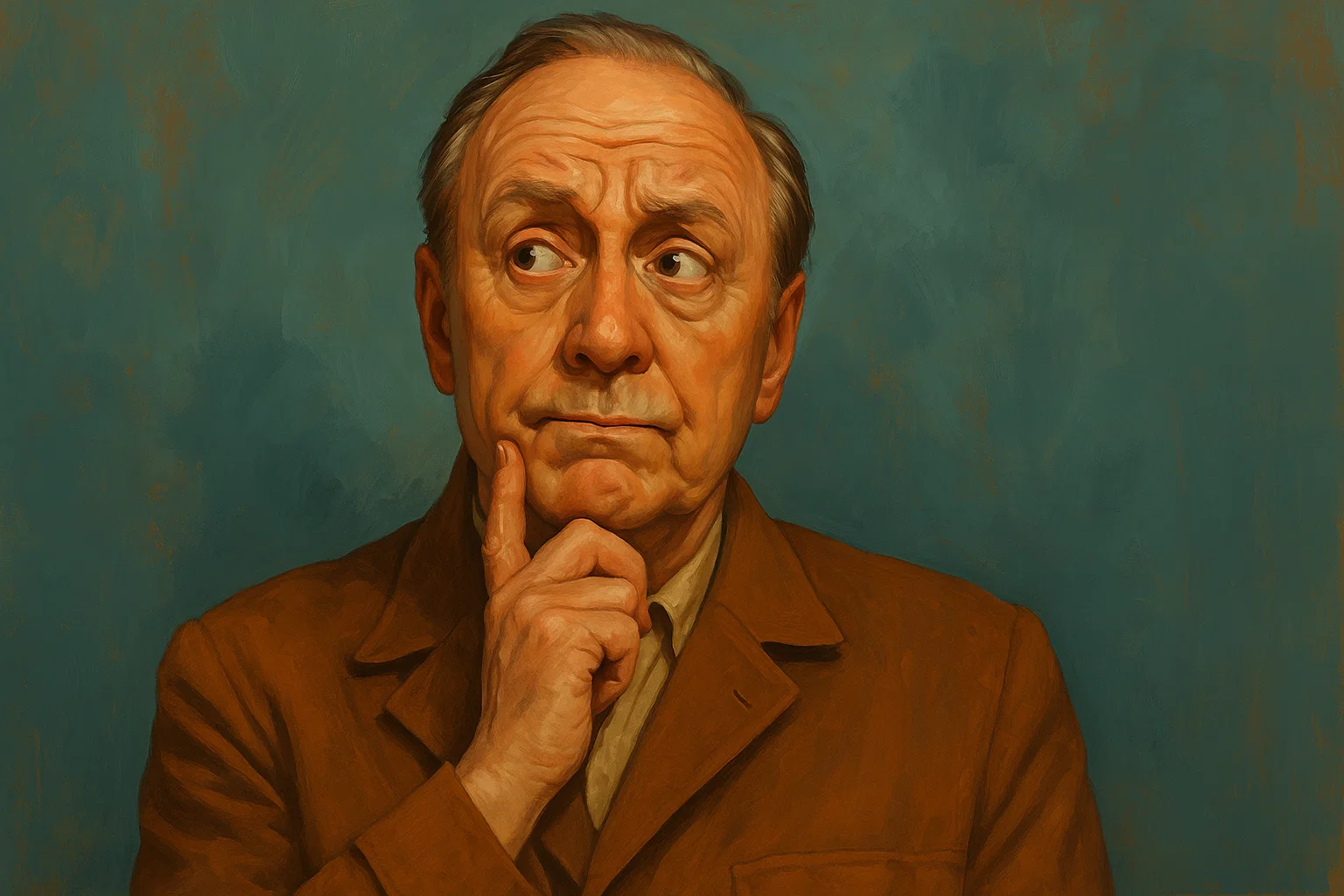
Born on February 14, 1894 (1894 - 1974) Jack BennyAmerican entertainer who evolved from a modest success as a violinist on the vaudeville circuit to one of the leading entertainers of the twentieth century with a highly popular comedic career in radio, television, and film |
 In 1909, Frederick Townsend Martin, “The Millionaire with a Mission” mocked the Metropolitan Life Tower as a monument to financial hubris, a glorified corporate temple built on exploited labor and questionable business ethics.
In 1909, Frederick Townsend Martin, “The Millionaire with a Mission” mocked the Metropolitan Life Tower as a monument to financial hubris, a glorified corporate temple built on exploited labor and questionable business ethics.
“Pity the jaded rich—they are only paupers in spirit, mere drifters, floating helplessly upon the froth of society. They deserve pity rather than envy, for if they disappeared tomorrow they would never be missed.”
— Frederick Townsend Martin
This fabricated human-interest story tries to tell us that the people who built the tallest building in New York (until 1913) that they were under the mire of “Death Takes a Holiday”. Moreover, it drops the name of Gertrude Robins. Known by codename: Minnie, Gertrude was a popular novelist and… spy! Namesakes appear in all of the media placements of “Death Takes a Holiday” to thank people who helped develop the security operations. While this group must remain secretive, it yells loudly to the future. This is only one bookend of the operation. From 1892-1912 this secretive group investigated “SubUrbia” which was the vast city that existed UNDER New York. Their story is hinted at via a television series made by George R.R. Martin, the discreet descendent of F.T. Martin, a man who was universally popular at the time, no matter how harsh he was when it came to describing “The Idle Rich”. Were there mutants under New York? That’ a story we’ll explore later sweethearts!
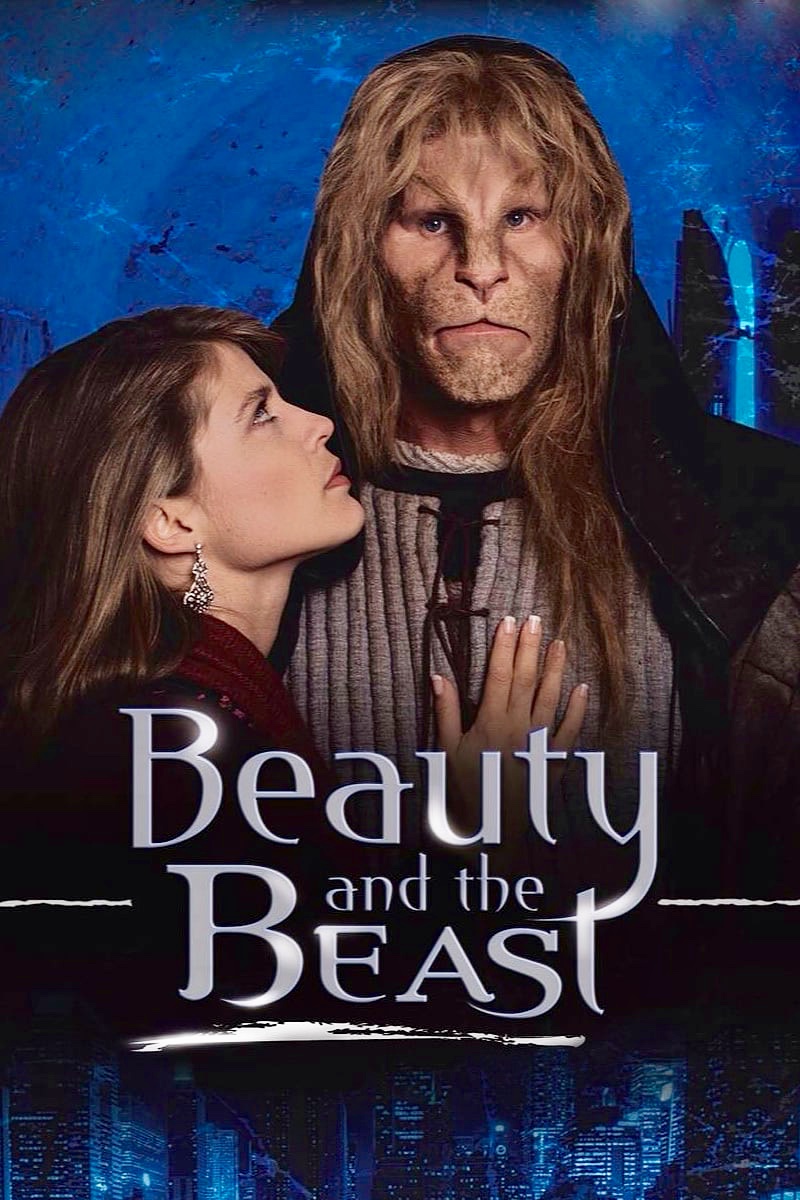
“I may often be in the midst of revelry, but always I am studying life.”
— Frederick Townsend Martin, The Passing of the Idle Rich (1911)
—
Original text from the article
Coroner Probing Death of Boy Killed Fleeing Kisses
Subpoenas Issued for Miss Gertrude Robbins and Other Employees of Company
Autopsy Shows Boy’s Heart Was Penetrated
An eraser in George S. Millett’s pocket penetrated his heart when he fell while fleeing playful kisses from office employees, an autopsy revealed today.
The autopsy, performed this afternoon by Dr. Lehane, Coroner’s Physician, established that George S. Millett, a fifteen-year-old office boy employed by the Metropolitan Life Insurance Company, died from a penetrating wound of the heart. The wound, located approximately two inches to the left of the median line beneath the eighth rib, took an upward course into the organ.
Subpoenas were issued today by Coroner Lehane Dooley for Miss Gertrude Robbins and several other company employees who allegedly participated in chasing the boy, intending to kiss him playfully.
Young Millett, who lived with his family, was reportedly fleeing from the playful advances of female co-workers at the time of his accidental death.
